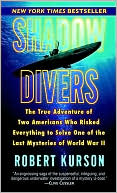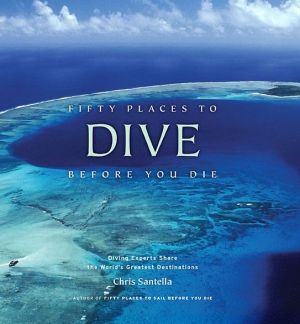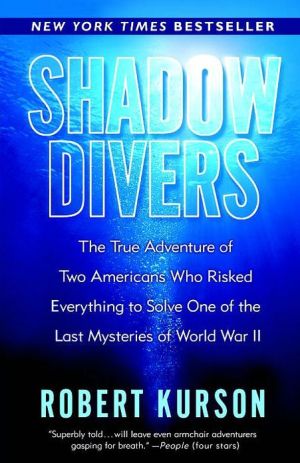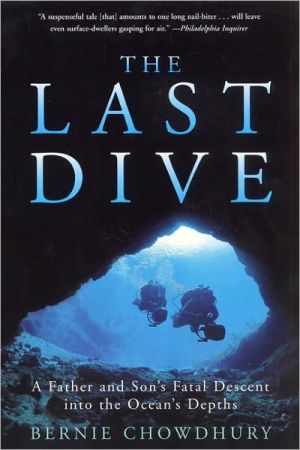Diver Down: Real-World Scuba Accidents and How to Avoid Them
One diver, after a seemingly brief period below the surface, discovers that his gas supply has run perilously low. Another, paralyzed, bobs helplessly on the surface, and when a poorly trained divemaster attempts rescue, things go from bad to worse. Two other divers, fascinated by the bountiful undersea life of the Caribbean, fail to notice that a powerful current is sweeping them rapidly away from their unattended boat.\ These are just a few of the true stories you’ll find in Diver Down,...
Search in google:
True Tales of Trouble in the Deep and What You Can Learn from ThemOne diver, after a seemingly brief period below the surface, discovers that his gas supply has run perilously low. Another, paralyzed, bobs helplessly on the surface, and when a poorly trained divemaster attempts rescue, things go from bad to worse. Two other divers, fascinated by the bountiful undersea life of the Caribbean, fail to notice that a powerful current is sweeping them rapidly away from their unattended boat.These are just a few of the true stories you’ll find in Diver Down, most of them involving diver error and resulting in serious injury or death. This unique survival guide explores the gamut of diving situations, including cave and wreck diving, deep-water dives, river and drift diving, decompression sickness, and much more. It shows you how to prevent tragic mishaps through: Inspection and maintenance of primary and secondary diving gear Learning and following established safety protocols Confirming the training and credentials of diving professionals Practicing emergency responses under real-world conditionsCaptain Michael R. Ange is the Managing Director of the Americas Division for the Professional Scuba Association International and contributing writer and technical editor for Scuba Diving magazine. During his diving career, Ange has trained more than 3,000 divers and several hundred instructors from around the world.Michael R.Ange is a senior member of theTechnical Training Staff for Scuba Diving International &Technical Diving International and contributing writer andtechnical editor for SCUBA Diving magazine. He has trained2,000 divers and hundreds of instructors and has written fivetextbooks on diving.
DIVER DOWN\ REAL-WORLD SCUBA ACCIDENTS AND HOW TO AVOID THEM \ \ By Michael R. Ange \ McGraw-Hill\ Copyright © 2006 Michael R. Ange\ All right reserved.\ ISBN: 978-0-07-177873-2 \ \ \ Chapter One\ THE "RESCUER" \ Thunk. Garrett is sure he counted right. That was the last weight belt hitting the bottom of the boat. Any moment now the crew will realize that he's lying helpless and paralyzed on the surface. The anxiety is overpowering; seconds seem like hours. Finally, he hears the divers on board call out. He tries once again to respond, but nothing seems to work. Although aware of everything going on around him, Garrett is unable to move, unable to speak, and unable to respond in any way. He senses, more than feels, the boat's divemaster reach him. Then he realizes his worst nightmare is unfolding as the divemaster removes his regulator and unknowingly pushes his head below the surface. He is aware of the seawater filling his airway, but he lacks all power to respond.\ Garrett was a healthy, active diver in his early fifties. His regular diving activities included cave diving, dives deeper than the recreational limits, and even some light inland commercial diving work. He was also an active instructor who earned his full-time living sharing his love of the underwater world with both the uninitiated and divers seeking more-advanced training. Garrett was, by any measure, a respected professional member of the diving community and industry. It was one of these professional commitments that transported him to Central America with a small group of divers for a guided diving excursion.\ Garrett and his wife, who was also a diving professional, had left their home in the United States very early that morning. The day had been laced with the usual travel concerns, anxieties, and anticipations that accompany a trip to exotic locales. They arrived with six enthusiastic divers in tow, looking forward to a week's relaxation and awesome diving in "paradise." Garrett understood all too well the travel issues that affect diver safety, such as fatigue and dehydration. Therefore he had insisted that everyone get a good night's sleep the night before the trip, and he was very insistent that they remain well hydrated since their first afternoon in country would include two relatively shallow-water reef dives. The divers deplaned and loaded their gear on the bus for the hours-long trip to the dive resort. In fact, the diving conditions at this resort were generally so good that the bus trip was frequently considered to be the most difficult and adventurous part of the vacation. Surviving the bus ride, the divers quickly unloaded, dumped their suitcases in the room, grabbed their dive gear, and boarded the small boat for the short trip to the reef and a late-afternoon dive.\ Conditions were everything that the resort advertised them to be. Seas were calm, currents nonexistent, and the visibility seemed unlimited as the eight divers rolled from the boat for a short reef dive. The dive was relatively shallow, averaging around 45 feet. No one in the group would exceed 60 feet. About 40 to 45 minutes into the dive, the well-supervised group ascended together to board the boat. Garrett surfaced with the group, making a quick head count to ensure that everyone was accounted for. As he completed the count, however, he felt numbness in his lower extremities. Alarmingly, it seemed to be moving rapidly up his body. He could sense that total paralysis was imminent. In a fraction of a second he made several decisions that he hoped would save his life.\ An experienced technical diver, Garrett tended to carry over many equipment selections from his technical gear setup to his recreational dives. He used a back-inflation, or "wings-style" BCD, which offers several advantages. Underwater, the air bladder, which is shaped like a horseshoe sandwiched between the diver's back and the scuba cylinder and wraps around the top and each side of the cylinder, provides a very stable swimming platform that helps the diver to maintain a position parallel to the surface. On the surface, this BCD can be fully inflated to provide a support very much like a raft with a weighted keel in the form of the cylinder. Garrett would take full advantage of this feature in the final seconds. As he realized what was happening, he fully inflated the BCD until it was rigid and supporting him faceup on the surface.\ Garrett knew that even the calmest of seas will wash over a diver's face and can cause him to inhale seawater. Fortunately, another of his gear selections would assist him with this dilemma. Technical divers typically use an elasticized cord to hold one of their second-stage regulators securely about the neck. These cords, commonly referred to as "suicide straps," allow the diver to recover the second-stage regulator using only his teeth in any emergency when his hands are occupied and, for whatever reason, there is no regulator in his mouth. To ensure proper fit and function, most technical divers make these devices themselves. Garrett was no exception. Although designed to hold the regulator around the neck, if the strap is pulled up higher around the head, it can also be used to secure the regulator in the diver's mouth. As Garrett was inflating his BCD, he quickly cinched up his suicide strap, effectively securing his second stage in his mouth. Fortunately, Garrett always strove to be a superior role model and thus had never removed his mask after surfacing. With his nose covered and the regulator in his mouth, Garrett hoped his airway would be effectively protected. Then, he was unable to move. Although the process sounds lengthy, in reality it took only a few seconds.\ All he could do now was wait. He was terrified, not knowing what body system would shut down next, but he focused on the fact that the divers would miss him as soon as they were aboard and he would be easily visible on the surface in the calm seas. As the divers boarded the small vessel, they handed their weight belts up to the crew and they were dropped into a basket on the boat's deck. Garrett could hear each belt dropping with a loud thunk. Carefully he counted them, marveling at his ability to hear and recognize what was going on even though he could not move. Finally, after what seemed an eternity, the seventh belt dropped into the basket. It was then that the dive group noticed Garrett floating motionless on the surface.\ The divemaster and boat's mate dove over the side, reaching him in a few short strokes. The divemaster was doing it by the book. He grabbed Garrett by the tank valve and began pulling him toward the boat. He jerked the regulator from Garrett's mouth and the mask from his face to determine if Garrett was breathing. Finding breath sounds, he began the tow to the boat, and that's where his "demonstration-quality" training failed to meet the needs of this emergency. In the rush of adrenaline and fear surrounding the rescue, nothing went as planned. As he attempted to hear the captain, the rescuer had his attention diverted toward the boat, never realizing that he had dragged Garrett's head below the surface. Garrett struggled to speak, tried to keep the water from his mouth, but he felt it flowing into his airway. Terror struck as he realized that the rescuer he thought would save him was actually going to drown him. Garrett could no longer breathe; however, fate soon stepped in once again to give him a reprieve. Stripping the gear from Garrett's body, the divers on board and the divemaster attempted to haul Garrett over the gunwale of the boat. Fortunately, Garrett's wet body slipped from their hands and he thudded facedown on the deck, forcing the water from his airway, which allowed him to breathe again. The crew placed Garrett on oxygen and made a mad dash for shore. Garrett was rushed to the nearest medical center, but this test of his will to survive was far from done yet.\ Garrett's care at the local medical facility was efficient, speedy, and, unfortunately, not appropriate for his injuries. The doctors probably properly diagnosed Garrett as a near drowning victim; however, no amount of discussion with the family or any of the other divers present would convince Garrett's doctors that the drowning was secondary to some form of hyperbaric injury. As a result, Garrett did not receive the hyperbaric oxygen treatment he so desperately needed until several days had passed. In fact, Garrett was not recompressed until his family was successful, with the assistance of numerous medical authorities and the U.S. Consulate, in getting him transported to Miami, Florida.\ We cannot be certain of exactly what type of hyperbaric injury Garrett sustained. However, the symptoms and the sudden onset seem to indicate an arterial gas embolism that quickly affected his central nervous system, with devastating results. The effects were exacerbated by the delay of more than 48 hours before effective treatment was initiated. Though it is remotely possible that the embolism formed because Garrett held his breath underwater, it is far more likely that a diver with his experience and aptitude sustained this injury as a result of some previously undetected temporary lung blockage. Although rare, in some cases divers may be affected by undiagnosed lung blockages caused by lung irritation or even the early onset of a variety of illnesses ranging from minor chest colds to pneumonia to more serious conditions like chronic obstructive pulmonary diseases such as emphysema.\ While any arterial gas embolism can be devastating both medically and emotionally, Garrett's situation was complicated by dive professionals who were inadequately trained or inadequately prepared to follow proper rescue procedures. When Garrett detected the onset of problems, he took every precaution to ensure his survival. He left his mask firmly in place when he surfaced, as every diver should do until he or she is safely on the boat. He further protected his airway by securing a second stage in his mouth and, most critically, he rapidly established positive, faceup buoyancy. It is likely that he accomplished all of this within seconds. Had Garrett been properly rescued at this point, diagnosis at the hospital would have been much simpler and his recompression therapy would almost assuredly have commenced earlier. However, Garrett's condition was aggravated by would-be rescuers who nearly drowned him. Based upon the accounts of bystanders, and his own memories, Garrett probably would not have survived the ordeal at all had it not been for the consistent incompetence of the crew, who dropped him facedown on the boat, allowing water to surge from his mouth and nose and clearing his obstructed airway.\ The introduction of seawater to Garrett's airway coupled with reports that he had been found floating unconscious on the surface convinced the local physicians that he was a near drowning victim. He was therefore treated as such without further diagnosis or treatment. By the time his family was able to arrange for transport, Garrett had been placed on a respirator and was unable to breathe on his own.\ After Garrett finally arrived in Miami, he received several recompression treatments. However, he did not respond well to them, and improvements were negligible. So, only a few days after his arrival, the family was called together so that the doctors could explain that the probability of Garrett's recovery was extremely slim and that they could see no advantages to further treatment. The family was unwilling to give up, though. Learning from the doctors that additional treatments would do no harm, although they were a "waste of time and money," the family convinced the doctors to take Garrett on one more chamber dive. During the descent something miraculous occurred: Garrett began breathing on his own. With this extremely positive outcome, Garrett's doctors decided to undertake more-aggressive treatment, and over the course of literally years, Garrett's recovery has continued to progress. His list of activities even includes shallow-water diving excursions once again.\ As an experienced diver who always strove to maintain his own skills, Garrett had a dramatic leg up on other divers who have found themselves in similar situations. He kept all of his equipment in place upon surfacing. He was in tune with his physical situation and recognized the onset of problems as soon as they began. He also recognized how fast his paralysis could occur. In spite of overwhelming odds, he remained calm. Had Garrett panicked and attempted to yell for assistance instead of protecting his airway, he probably would not have survived. His survival chances would also have been diminished if he had dropped his mask and removed his regulator upon surfacing in the calm seas, as so many divers do. In the end, Garrett's familiarity with proper procedures, his experience with his own equipment, and his calm response were probably the most significant factors in his survival.\ Strategies for Survival\ \ Question the professionals who will be supervising your diving activities and instruction to make sure they are qualified. Do not hesitate to query them about the type of training they have received and the last time it was updated.\ \ \ Take the time to become intimately familiar with your dive gear in controlled circumstances before venturing to open water. Know how every feature works, especially the features you don't use on every dive.\ \ \ Be calm, even in the face of disaster. Panic is the number one killer of scuba divers, and it will never improve your odds of survival.\ \ \ Prepare an emergency response plan both for in the water and for after an injury is confirmed. Be sure your dive buddies know how to implement it and that they are committed to seeing it through.\ \ \ If you want training in critical skills, such as rescue, be sure it is for the real world, not some imaginary utopia. Demonstration-quality performance is admirable, but it will rarely provide you with skills that are truly "lifesaving."\ \ Chapter Two\ THE SAILORS' COLD AND LONELY NIGHT \ Suddenly, a cold chill sends a shiver through Tonya's body. Something doesn't feel right. Ascending a few feet off the reef, she notices that she's suddenly moving along much faster than she intends, even though she's not swimming at all. Kicking ahead a few strokes, she grabs Robert by the leg, signaling that they need to surface. He glances at his gauges and, seeing plenty of air and bottom time remaining, signals back that everything is OK. Pointing at the reef, Tonya tries frantically to get Robert to observe the speed of the current. Finally, he notices that the large and colorful sea fans are bent almost 90 degrees and realizes that they are being swept away from their unmanned boat. In a state of extreme anxiety, they begin a rapid ascent to the surface.\ Tonya and Robert were a professional couple in their mid-thirties who were very athletic and active in many outdoor sports. Two of their most passionate activities were sailing and diving. Robert was an experienced blue-water sailor who, starting when he was a teenager, had made many passages from the southern United States to the islands of the tropics. Although less experienced, Tonya had become a capable first mate on Robert's numerous short excursions to offshore waters. They were also both fairly active divers. They had been recently certified as advanced divers, and they took frequent late-afternoon or Saturday morning trips to a freshwater lake near their home just to get wet. In addition to taking every opportunity to get to the Caribbean, Tonya and Robert often made weekend excursions to the warm tropical waters of south Florida. Between them, they had logged more than 150 dives in the four and a half years they had been diving. Most of these dives were made with organized dive groups or commercial charter operators, both of which offered the services of a divemaster for in-water supervision. Aside from a few dives in the calm waters of their local lake, they had never made an unsupervised dive prior to this vacation.\ When Tonya received a big promotion at her job, the two found an ideal excuse to take an extended vacation to the Caribbean. They spent several weekends prepping Robert's sailboat and then a couple more weekends moving it down the coast of Florida to a convenient jumping-off point for the voyage to a popular island chain in the Caribbean. Remembering everything they had been taught in training, they carefully prepared all their primary dive gear for the trip as well. BCDs and regulators were taken to the local dive shop for servicing and a last-minute tune-up. Mask straps, fin straps, and buckles were all inspected. Finally, the gear was properly stored aboard the boat in anticipation of several diving excursions to come.\ (Continues...)\ \ \ \ \ Excerpted from DIVER DOWN by Michael R. Ange Copyright © 2006 by Michael R. Ange. Excerpted by permission of McGraw-Hill. All rights reserved. No part of this excerpt may be reproduced or reprinted without permission in writing from the publisher.\ Excerpts are provided by Dial-A-Book Inc. solely for the personal use of visitors to this web site. \ \
Special Topics ContentsPreface: Dive Safety and This BookAcknowledgmentsIntroduction: Scuba 101The "Rescuer"The Sailors' Cold and Lonely NightDying for MaintenanceA Killer Wreck DiveGood IntentionsThe Public Safety DiverThe Inexperienced Professional and an EgoThe “Trust-Me” DiveKiller ArroganceA Killer ShortcutHazards to NavigationA Simple Commercial DiveThe Dive Plan Failure: Narcosis Is for EveryoneA Snug-Fitting SuitThe Little Details That Get YouThe Expedient Gear TechnicianPracticing What You PreachThe Folly of YouthYou Can't Buy Common SenseThe “Top Guns”About the AuthorIndex







